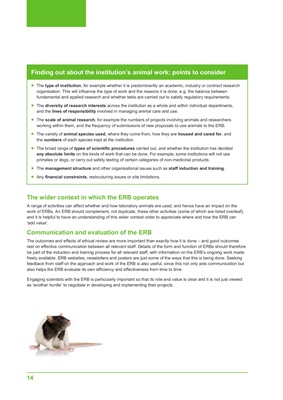
14
Finding out about the institution"s animal work: points to consider
The type of institution, for example whether it is predominantly an academic, industry or contract research
organisation. This will influence the type of work and the reasons it is done, e.g. the balance between
fundamental and applied research and whether tests are carried out to satisfy regulatory requirements.
The diversity of research interests across the institution as a whole and within individual departments,
and the lines of responsibility involved in managing animal care and use.
The scale of animal research, for example the numbers of projects involving animals and researchers
working within them, and the frequency of submissions of new proposals to use animals to the ERB.
The variety of animal species used, where they come from, how they are housed and cared for, and
the numbers of each species kept at the institution.
The broad range of types of scientific procedures carried out, and whether the institution has decided
any absolute limits on the kinds of work that can be done. For example, some institutions will not use
primates or dogs, or carry out safety testing of certain categories of non-medicinal products.
The management structure and other organisational issues such as staff induction and training.
Any financial constraints, restructuring issues or site limitations.
The wider context in which the ERB operates
A range of activities can affect whether and how laboratory animals are used, and hence have an impact on the
work of ERBs. An ERB should complement, not duplicate, these other activities (some of which are listed overleaf),
and it is helpful to have an understanding of this wider context order to appreciate where and how the ERB can
'add value'.
Communication and evaluation of the ERB
The outcomes and effects of ethical review are more important than exactly how it is done - and good outcomes
rest on effective communication between all relevant staff. Details of the form and function of ERBs should therefore
be part of the induction and training process for all relevant staff, with information on the ERB"s ongoing work made
freely available. ERB websites, newsletters and posters are just some of the ways that this is being done. Seeking
feedback from staff on the approach and work of the ERB is also useful, since this not only aids communication but
also helps the ERB evaluate its own efficiency and effectiveness from time to time.
Engaging scientists with the ERB is particularly important so that its role and value is clear and it is not just viewed
as "another hurdle" to negotiate in developing and implementing their projects.